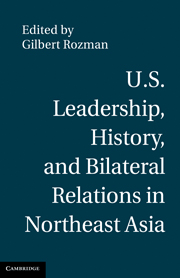Book contents
- Frontmatter
- Contents
- List of Contributors
- Acknowledgments
- U.S. Leadership, History, and Bilateral Relations in Northeast Asia
- Introduction
- PART I HISTORICAL MEMORIES AND BILATERAL TIES WITH ALLIES
- PART II HISTORICAL MEMORIES, JAPANESE–SOUTH KOREAN RELATIONS, AND U.S. VALUES
- PART III HISTORICAL MEMORIES, SINO–SOUTH KOREAN RELATIONS, AND U.S. VALUES
- 7 Sino–South Korean Differences over Koguryo and the U.S. Role
- 8 New Grounds for Contestation
- 9 U.S. Strategic Thinking on Sino–South Korean Differences over History
- Index
7 - Sino–South Korean Differences over Koguryo and the U.S. Role
from PART III - HISTORICAL MEMORIES, SINO–SOUTH KOREAN RELATIONS, AND U.S. VALUES
Published online by Cambridge University Press: 01 March 2011
- Frontmatter
- Contents
- List of Contributors
- Acknowledgments
- U.S. Leadership, History, and Bilateral Relations in Northeast Asia
- Introduction
- PART I HISTORICAL MEMORIES AND BILATERAL TIES WITH ALLIES
- PART II HISTORICAL MEMORIES, JAPANESE–SOUTH KOREAN RELATIONS, AND U.S. VALUES
- PART III HISTORICAL MEMORIES, SINO–SOUTH KOREAN RELATIONS, AND U.S. VALUES
- 7 Sino–South Korean Differences over Koguryo and the U.S. Role
- 8 New Grounds for Contestation
- 9 U.S. Strategic Thinking on Sino–South Korean Differences over History
- Index
Summary
After three years of fierce fighting in the Korean War and a forty-year cold war confrontation, the PRC and the ROK put an end to their antagonism and established formal diplomatic ties in August 1992. Stimulated by fast-growing economic and strategic common interests, relations between these states have made remarkable progress in almost all fields, and the two countries announced “the establishment of an all-around cooperative partnership” in 2003, only one decade after normalization. Economically, China had not only become the ROK's largest destination for foreign direct investment (FDI) since 2001, but also surpassed the United States as South Korea's largest trading partner by 2004; strategically, the two countries have shared increasingly converging security interests in maintaining peace and stability on the Korean peninsula, especially diplomatic cooperation in dealing with the nuclear weapons program pursued by the DPRK since 2002; and socially, the number of visits between the two countries' leaders and peoples has also grown remarkably since normalization.
During the first decade of diplomatic relations, mutual fever between the two nations – the “South Korea wave” in China and the “China fever” in South Korea – elevated bilateral ties at the grass-roots as well as the official level. Expectations were raised that the two may draw even closer, to the extent of becoming strategic allies on a par with the alliance between the United States and South Korea.
- Type
- Chapter
- Information
- Publisher: Cambridge University PressPrint publication year: 2010

